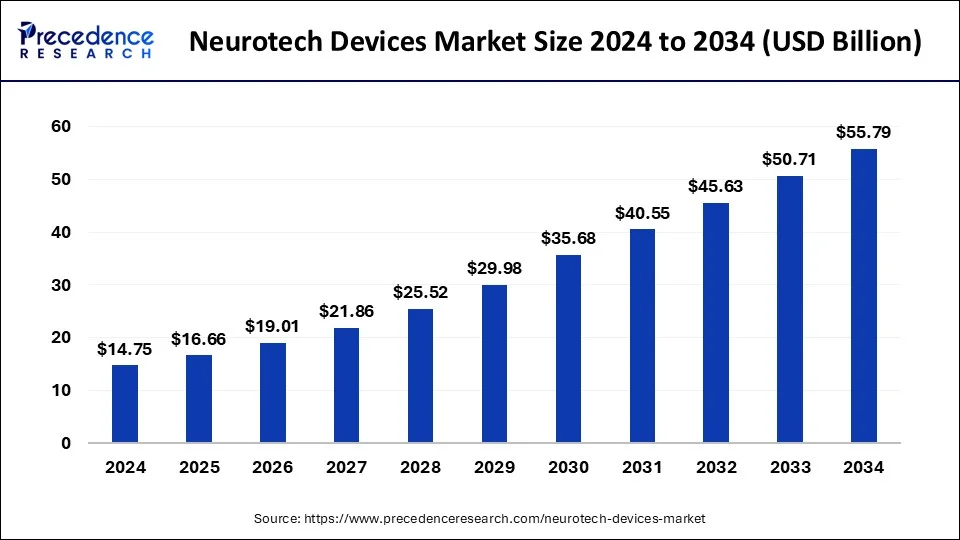The global neurotech devices market size was estimated at USD 14.75 billion in 2024 and is predicted to increase from USD 16.66 billion in 2025 to approximately USD 55.79 billion by 2034, expanding at a CAGR of 14.37% from 2025 to 2034. The market growth is driven by the increasing adoption of neurotechnology devices in treating neurological disorders, rehabilitation, and cognitive health management.

Neurotech Devices Market Size 2025 to 2034
-
Market Size 2024: USD 14.75 billion
-
Market Size 2025: USD 16.66 billion
-
Market Size 2034: USD 55.79 billion
-
Growth Rate: CAGR of 14.37% (2025–2034)
Neurotech Devices Market Key Takeaways
-
North America dominated with the largest share of 54.9% in 2024.
-
Asia Pacific is projected to witness the fastest growth during the forecast period.
-
By product, the neurostimulation segment accounted for a 67.6% share in 2024.
-
By condition, the pain management segment held the largest share (57.9% in 2024).
-
By end use, the hospital segment generated the highest share (39.2% in 2024).
Role of Artificial Intelligence in the Neurotech Devices Market
Artificial Intelligence (AI) is transforming neurotech by enabling real-time brain mapping, adaptive stimulation, predictive analytics, and closed-loop systems in neurostimulation and brain-computer interfaces (BCIs). AI-powered systems improve accuracy in interpreting brain signals, enhance decision-making for clinicians, and allow more personalized treatment approaches for conditions such as epilepsy, Parkinson’s disease, and depression.
AI is also supporting the integration of wearable neurotech into consumer wellness, while raising ethical concerns around brain data privacy and neuro-rights, which are expected to remain a key focus area as adoption accelerates.
Market Dynamics
Drivers
-
Rising incidence of neurological disorders (affecting over 1 billion people globally, WHO).
-
Growing elderly population and life expectancy.
-
Rapid technological advancements in BCIs, neurostimulation, and AI-driven diagnostics.
-
Growing acceptance of non-invasive and wearable neurotech devices.
Restraints
-
Ethical concerns regarding neuro-rights, brain data privacy, and personhood.
-
High costs and technological complexity in device development.
Opportunities
-
Breakthroughs in BCIs, neuroprostheses, and wearable cognitive monitoring devices.
-
Increasing government initiatives and funding (e.g., U.S. BRAIN Initiative, EU support programs).
-
Expanding consumer adoption of digital health and neurotech-integrated platforms.
Market Scope
| Report Coverage | Details |
|---|---|
| Market Size by 2034 | USD 55.79 Billion |
| Market Size in 2025 | USD 16.66 Billion |
| Growth Rate (2025–2034) | CAGR of 14.37% |
| Dominating Region | North America |
| Fastest Growing Region | Asia Pacific |
| Base Year | 2024 |
| Forecast Period | 2025–2034 |
| Segments Covered | Product Type, Condition, End-user, Region |
Neurotech Devices Market Growth Factors
-
Rising Prevalence of Neurological Disorders
-
Increasing cases of Alzheimer’s disease, Parkinson’s disease, epilepsy, migraine, and chronic pain are fueling the adoption of neurotech solutions.
-
According to WHO, neurological conditions affect over 1 billion people globally, creating sustained demand for advanced treatment technologies.
-
-
Aging Global Population
-
The growing geriatric population is more susceptible to neurodegenerative conditions, driving long-term demand for neurostimulation, neuroprostheses, and rehabilitation devices.
-
-
Technological Advancements
-
Rapid progress in brain-computer interfaces (BCIs), neurostimulation systems, neurosensing technologies, and AI integration is boosting device effectiveness, safety, and personalization.
-
Miniaturization and wearable neurotech are expanding clinical and consumer applications.
-
-
Artificial Intelligence and Machine Learning Integration
-
AI-enabled neurotech improves real-time brain mapping, adaptive stimulation, and predictive analytics, enhancing treatment outcomes.
-
AI is also enabling closed-loop systems and automation for personalized neurological care.
-
-
Growing Demand for Non-invasive and Wearable Neurotech
-
The shift towards non-invasive devices and consumer-grade wearables for mental wellness, cognitive monitoring, and lifestyle applications is broadening the market beyond clinical use.
-
Recent Developments
-
July 2025: Neuralink’s first public recipient successfully controlled a cursor and drew using a brain implant.
-
March 2025: CorTec GmbH’s flexible electrode device implanted in stroke survivors at University of Washington.
-
April 2025: Precision Neuroscience’s FDA-cleared Layer 7 Cortical Interface enabled diagnostic cortical implants.
-
January 2024: Rune Labs raised USD 12M to expand precision neurology software solutions.
Read Also: Fertility Market
For inquiries regarding discounts, bulk purchases, or customization requests, please contact us at sales@precedenceresearch.com
- Wearable Cardiac Devices Market Size to Hit USD 32.16 Bn by 2034 - September 19, 2025
- Neurotech Devices Market Size to Hit USD 55.79 Billion by 2034 - September 19, 2025
- Fertility Market Size to Hit USD 85.53 Billion by 2034 - September 19, 2025
